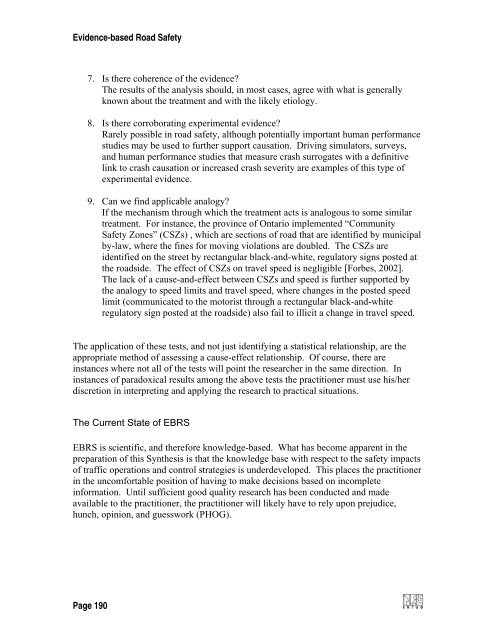Synthesis of Safety for Traffic Operations - Transports Canada
Synthesis of Safety for Traffic Operations - Transports Canada
Synthesis of Safety for Traffic Operations - Transports Canada
You also want an ePaper? Increase the reach of your titles
YUMPU automatically turns print PDFs into web optimized ePapers that Google loves.
Evidence-based Road <strong>Safety</strong><br />
7. Is there coherence <strong>of</strong> the evidence?<br />
The results <strong>of</strong> the analysis should, in most cases, agree with what is generally<br />
known about the treatment and with the likely etiology.<br />
8. Is there corroborating experimental evidence?<br />
Rarely possible in road safety, although potentially important human per<strong>for</strong>mance<br />
studies may be used to further support causation. Driving simulators, surveys,<br />
and human per<strong>for</strong>mance studies that measure crash surrogates with a definitive<br />
link to crash causation or increased crash severity are examples <strong>of</strong> this type <strong>of</strong><br />
experimental evidence.<br />
9. Can we find applicable analogy?<br />
If the mechanism through which the treatment acts is analogous to some similar<br />
treatment. For instance, the province <strong>of</strong> Ontario implemented “Community<br />
<strong>Safety</strong> Zones” (CSZs) , which are sections <strong>of</strong> road that are identified by municipal<br />
by-law, where the fines <strong>for</strong> moving violations are doubled. The CSZs are<br />
identified on the street by rectangular black-and-white, regulatory signs posted at<br />
the roadside. The effect <strong>of</strong> CSZs on travel speed is negligible [Forbes, 2002].<br />
The lack <strong>of</strong> a cause-and-effect between CSZs and speed is further supported by<br />
the analogy to speed limits and travel speed, where changes in the posted speed<br />
limit (communicated to the motorist through a rectangular black-and-white<br />
regulatory sign posted at the roadside) also fail to illicit a change in travel speed.<br />
The application <strong>of</strong> these tests, and not just identifying a statistical relationship, are the<br />
appropriate method <strong>of</strong> assessing a cause-effect relationship. Of course, there are<br />
instances where not all <strong>of</strong> the tests will point the researcher in the same direction. In<br />
instances <strong>of</strong> paradoxical results among the above tests the practitioner must use his/her<br />
discretion in interpreting and applying the research to practical situations.<br />
The Current State <strong>of</strong> EBRS<br />
EBRS is scientific, and there<strong>for</strong>e knowledge-based. What has become apparent in the<br />
preparation <strong>of</strong> this <strong>Synthesis</strong> is that the knowledge base with respect to the safety impacts<br />
<strong>of</strong> traffic operations and control strategies is underdeveloped. This places the practitioner<br />
in the uncom<strong>for</strong>table position <strong>of</strong> having to make decisions based on incomplete<br />
in<strong>for</strong>mation. Until sufficient good quality research has been conducted and made<br />
available to the practitioner, the practitioner will likely have to rely upon prejudice,<br />
hunch, opinion, and guesswork (PHOG).<br />
Page 190
















